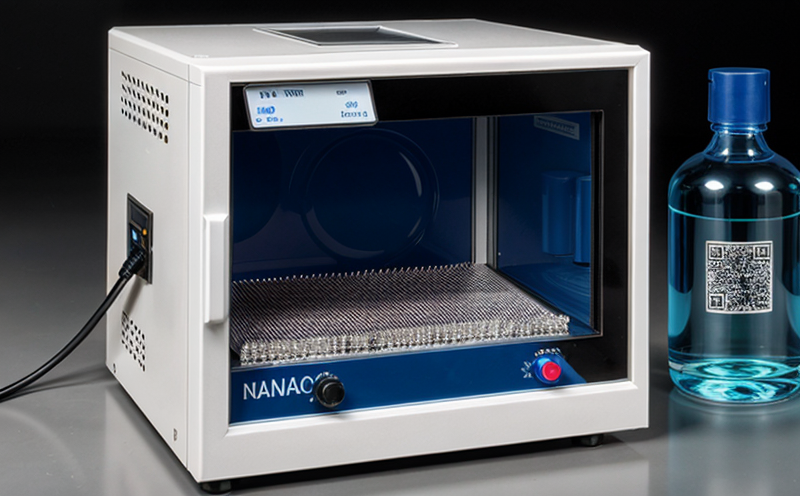ASTM E3143 Nanoparticle Surface Chemistry Testing
The ASTM E3143 standard provides a comprehensive approach to quantifying and characterizing the surface chemistry of nanoparticles. This test is crucial for industries involved in nanotechnology, particularly those dealing with pharmaceuticals, electronics, materials science, and environmental sciences where understanding the interaction between nanoparticle surfaces and their environment is essential.
The ASTM E3143 method is designed to determine the chemical composition and reactivity of the surface layer of nanoparticles. This includes identifying functional groups present on the particle surface, assessing the stability of these groups under different environmental conditions, and evaluating how they might interact with surrounding materials or biological systems.
The test involves several key steps: sample preparation, cleaning to remove contaminants, dispersion of the nanoparticles in a suitable solvent, followed by analysis using advanced spectroscopic techniques such as X-ray Photoelectron Spectroscopy (XPS), Fourier Transform Infrared Spectroscopy (FTIR), and Scanning Electron Microscopy with Energy Dispersive X-ray Analysis (SEM-EDAX). These methods allow for precise determination of the elemental composition and chemical states at the nanoparticle surface.
One critical aspect of ASTM E3143 is its focus on replicating real-world conditions. This means that tests are conducted under various pH levels, temperatures, and humidity to simulate different environmental stresses nanoparticles might encounter during manufacturing or use. Understanding these interactions helps ensure that the nanoparticles behave predictably in their intended applications.
The results from ASTM E3143 are invaluable for quality control, ensuring consistency across batches of manufactured nanoparticles. Compliance with this standard also facilitates smoother international trade by meeting regulatory requirements set by various countries and regions. Additionally, it supports ongoing research into the development of safer and more effective nanomaterials.
For R&D engineers working on cutting-edge technologies involving nanoparticles, ASTM E3143 provides a robust framework for optimizing product performance while minimizing potential risks associated with nanoparticle exposure. By providing detailed insights into surface chemistry, this test aids in designing safer products and processes.
Applied Standards
| Standard Name | Description |
|---|---|
| ASTM E3143-20 Standard Practice for Quantifying and Characterizing the Surface Chemistry of Nanoparticles | This standard outlines procedures for quantifying and characterizing the surface chemistry of nanoparticles, including methods for determining elemental composition, functional groups, and reactivity. |
Why Choose This Test
Selecting ASTM E3143 nanoparticle surface chemistry testing is advantageous for several reasons. Firstly, it offers a standardized approach that ensures consistency and reliability of results across different laboratories. Secondly, compliance with this standard can significantly reduce regulatory barriers when exporting products internationally. Thirdly, the detailed information provided by ASTM E3143 helps improve product quality through enhanced understanding of how nanoparticle surfaces behave under various conditions.
For companies involved in nanotechnology research and development, choosing ASTM E3143 allows them to stay at the forefront of technological advancements. It enables better decision-making regarding material selection and process optimization based on precise surface chemistry data. Furthermore, adherence to this standard demonstrates a commitment to safety and quality standards expected by customers and regulatory bodies alike.
The test's ability to predict nanoparticle behavior under different environmental conditions makes it particularly useful for industries where nanoparticles are used extensively. Whether in pharmaceuticals, electronics, or environmental applications, understanding the surface chemistry of these materials is crucial for ensuring product efficacy and safety.
International Acceptance and Recognition
The ASTM E3143 standard has gained widespread acceptance globally due to its rigorous methodology and comprehensive coverage. Many countries have adopted this standard as part of their national regulations for nanomaterials, recognizing its importance in ensuring safe and effective use of these materials.
International organizations such as the Organization for Economic Co-operation and Development (OECD) reference ASTM E3143 when developing guidelines for assessing nanoparticle toxicity. This recognition underscores the reliability and relevance of this standard within the broader scientific community.
The increasing adoption of ASTM E3143 reflects a growing awareness among stakeholders about the necessity of detailed knowledge regarding nanoparticle surface chemistry. As nanotechnology continues to expand into new sectors, the importance of standards like ASTM E3143 will only grow, providing a foundation for responsible innovation and development.





